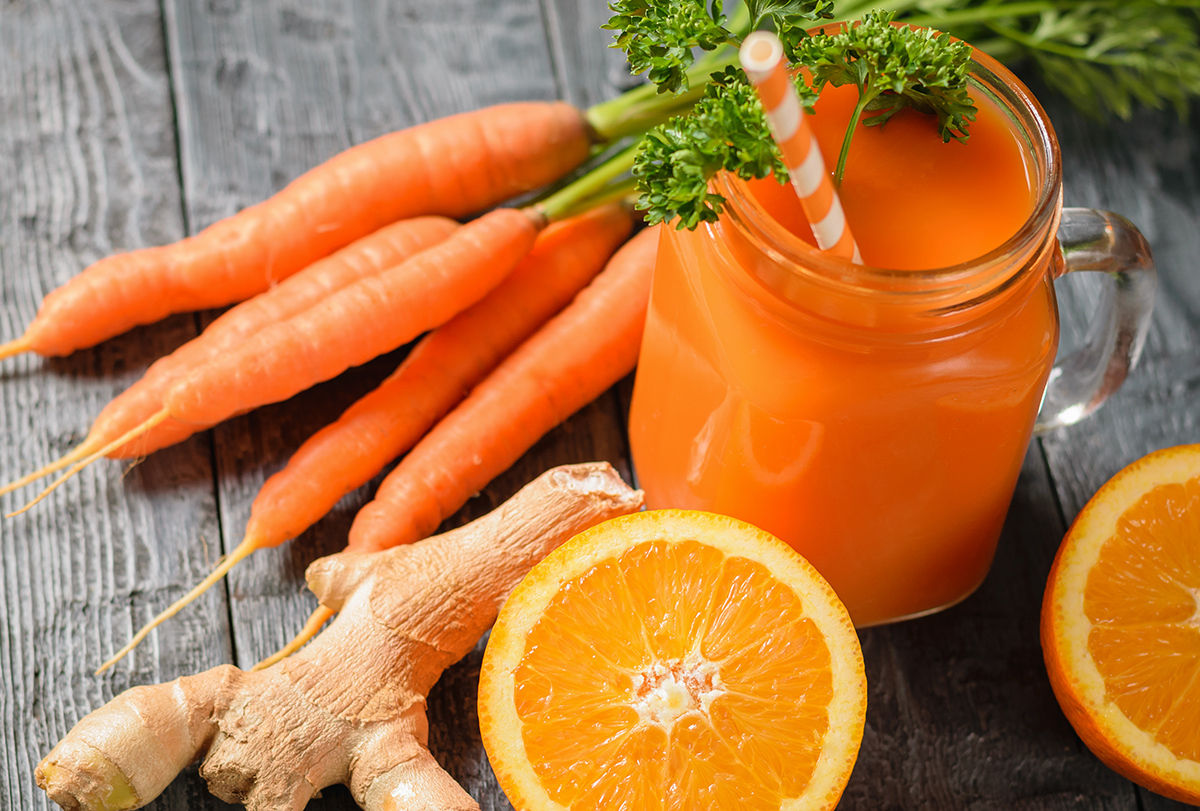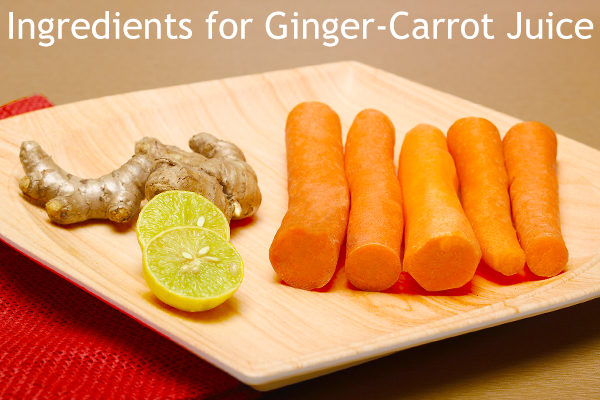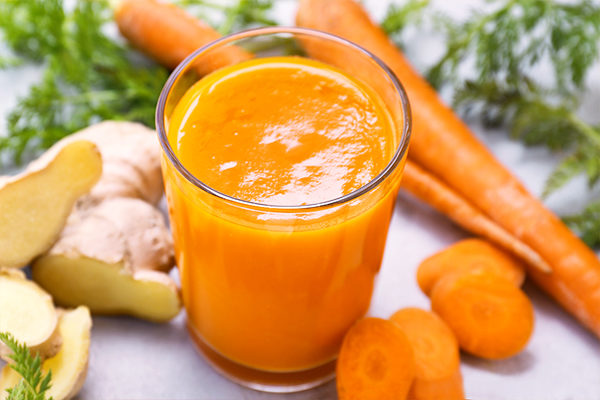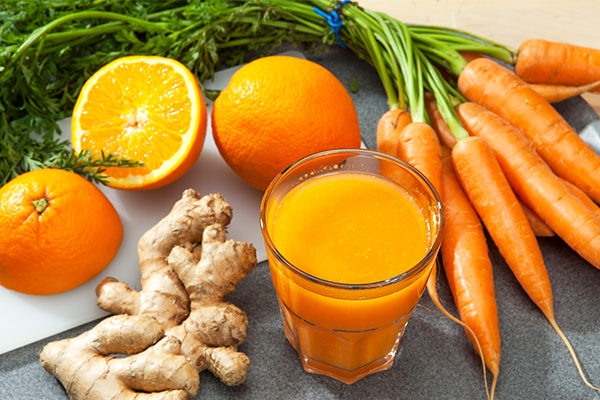In this article:
Many people are looking for ways to stay healthy and have glowing skin. Following a well-balanced, nutrient-rich diet can be a good head start for staying healthy and obtaining nutrients that support skin health.

Consuming more fruits and vegetables, even as a drink, is an easy way to get these vital nutrients. A prime example of such a health drink is fresh ginger-carrot juice.
About the Chief Ingredients
Ginger and carrot can improve your health in many ways.
Carrots
Carrots have been used across many cultures for centuries in the form of soups and juices due to their natural sweetness and health properties. Some other important benefits of consuming carrots are:
- Carrots are a good source of carotenoids, namely, beta-carotene, which is the pro-vitamin form of vitamin A and the antioxidants lutein and zeaxanthin. (1)
- Carotenoids have been associated with immune-boosting effects and a lower risk of certain degenerative diseases. (2)
- Carrots may promote skin health, as beta-carotene exhibits moderate UV protection, which may help prevent sunburns. (3)
- The beta-carotene, lutein and zeaxanthin in carrots are also beneficial for eye health. (4)
- Carrot intake is likely to be associated with a reduced risk of certain cancers (5)(6)(7) and improved cardiac health. (8)(9) However, there is a need for further conclusive research.
- Carrots are a source of many other nutrients, including potassium, magnesium, manganese, iron, and fiber. They are also naturally low in sodium, calories, and fat.
Ginger
Ginger roots contain active compounds called gingerols, which impart flavor and fragrance that this rhizome is known for.
The juice extracted from ginger has quite a spicy, strong, and pungent taste and is often diluted before consumption. While it may sound laborious, juicing ginger is fairly easy.
Like carrots, ginger provides many health benefits:
- Ginger demonstrates potent antioxidant and anti-inflammatory properties (10)(11) that contribute to the strengthening of the immune system. (12)
- The gingerols in ginger help alleviate morning sickness and nausea. (13)(14)
- Ginger is also known as a carminative, a substance that helps eliminate excessive gas from the digestive system. For centuries, ginger has been used as a remedy for colic and dyspepsia.
- Ginger is known to have analgesic properties that help in relieving pain associated with menstruation. (15)(16)
Benefits of Using Ginger-Carrot Together
Both ginger and carrots are not only rich in minerals, vitamins, and antioxidants, but they also complement each other in terms of taste. They blend well together, with the sweet taste of carrots blunting the strong flavor of ginger to make a refreshing and tasty beverage.
You can further enhance the taste and nutritional value of this drink by adding other health-promoting ingredients, such as lemon and cinnamon.
Lemons are rich in vitamin C, a strong antioxidant that is beneficial for your skin and immunity. (17) Vitamin C also exhibits anti-inflammatory effects to fight obesity and metabolic syndrome. (18)
Safety Precautions
It may be unsafe for babies and young children to consume large amounts of carrot juice as it can result in yellowing of the skin and possible tooth decay. (19) Some adults may also experience these effects.
Additionally, ensure that you are not allergic to carrots before consuming this drink. Carrot allergy is often linked to birch pollen allergy and celery-carrot-mugwort-spice syndrome but is less frequent than these. It is also vital to rule out a ginger allergy. Consumption of ginger can occasionally have mild side effects, such as stomach discomfort, diarrhea, and heartburn.
Ginger may also stimulate insulin production and lower blood sugar levels in some instances. Consult your medical practitioner before consuming ginger or for the adjustment of your medications.
Ginger-Carrot Juice Recipes
The ingredients required for a fresh ginger-carrot juice are generally present in all households. Follow these easy recipes for a revitalizing beverage.
1. Fresh Ginger-Carrot Juice
Ingredients:

- 4–5 carrots
- ½-inch ginger root
- ½ lemon
- Cinnamon powder (optional)
- Sea salt (optional)
Directions:

- Rinse the carrots with water and peel if desired.
- Remove the outer covering of the ginger root if desired.
- Rinse the lemon and cut off the rind and white pith.
- Extract the juice from the carrots, ginger, and lemon using a juicer.
- Pour the juice into a glass (makes one serving).
- Sprinkle a pinch of sea salt and cinnamon and mix well.

The extra juice may be stored in the fridge for a day.
2. Orange-Carrot-Ginger Juice
This juice, with only three high-antioxidant ingredients, is a delectable drink that will boost your immune system. Adding oranges helps enhance the color and flavor of the drink and also provides additional nutrients.
Oranges have high amounts of vitamin C (20) that strengthens the immune system and promotes quick healing. (21) Their fiber content aids digestion and gives a feeling of fullness. (22)
Ingredients:
- 7 oranges
- 4 carrots
- 2 ½-inch ginger root (fresh)
Directions:
- Rinse the oranges and cut out the rind and pith. Cut them in half.
- Rinse the carrots and peel if desired. Chop out the ends of the carrots and cut them into smaller pieces.
- Peel the ginger using a spoon if desired.
- Process the oranges, ginger, and carrots using a blender or juicer.
- Alternatively, you may process the fruits on high for 1 minute and sieve the juice using a fine strainer or nut milk bag into a jug in batches.
- Pour into 2 glasses and consume immediately.

The extra juice may be stored in the fridge for a day. To reduce wastage, you can use the pulp in a soup, stew, or smoothie or even freeze it for later use.
Additional Tips
- It is recommended to consume this health drink immediately, as it loses its nutritional value as time passes due to oxidation.
- You may also add two celery stalks or a green apple to the juice.
- Adding herbs such as sweet basil, mint, and parsley will enhance the taste.
- You can also add honey to make the drink sweeter if desired.
- The flavor may vary with different types of carrots.
Final Word
Carrot-ginger juice is an excellent substitute for any sweetened carbonated drink. It refreshes you with the additional advantage of its health benefits. You may consume it as a part of your breakfast or as a snack. Furthermore, you are not restricted to the specified ingredients.
Take liberty to switch the constituents with other healthy options to enhance the taste and reap more benefits.
- Was this article helpful?
- YES, THANKS!NOT REALLY


